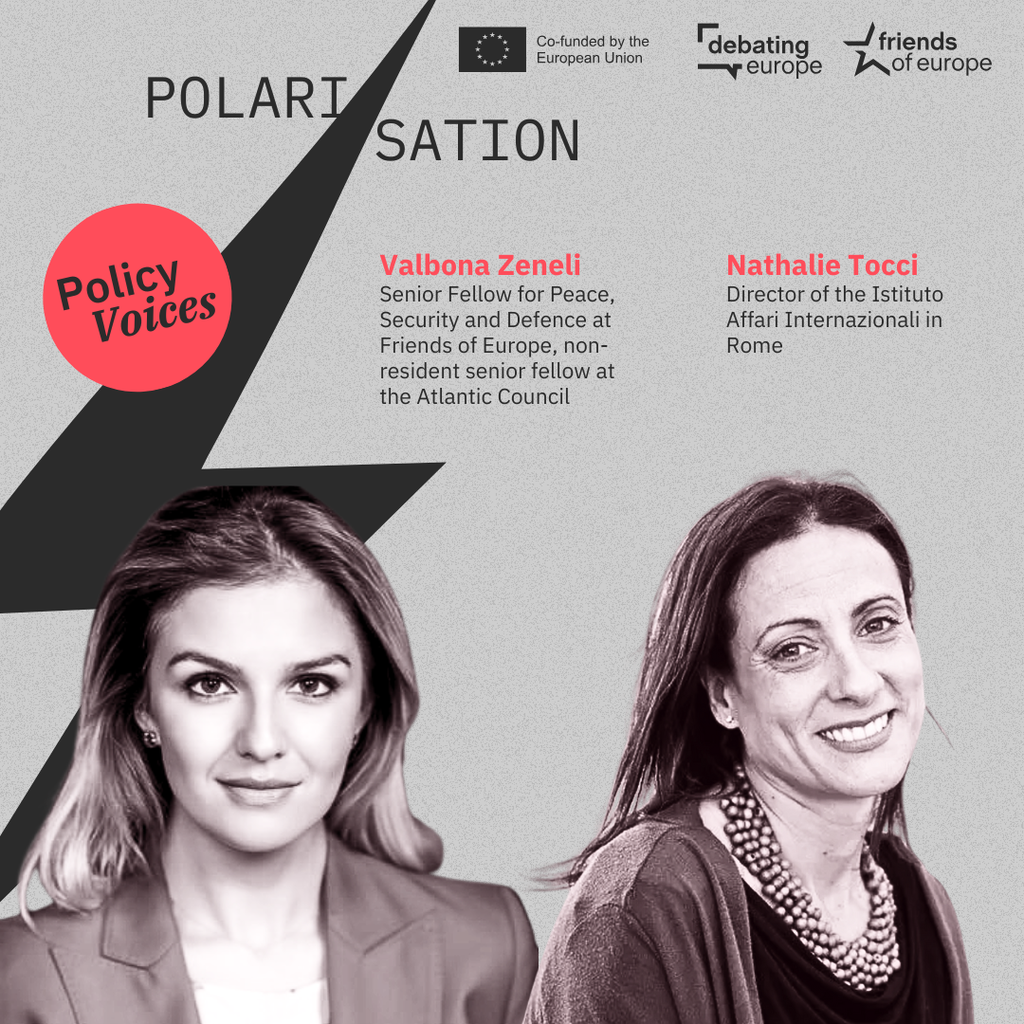From ambition to action: building Europe’s Defence Union
Past event In person

- Area of Expertise
- Peace, Security & Defence
Peace, Security & Defence

Senior Fellow for Peace, Security and Defence at Friends of Europe, and former Deputy Assistant Secretary General for Emerging Security Challenges at the North Atlantic Treaty Organization (NATO)
One of the greatest Secretary-Generals of the United Nations, Dag Hammerskjöld, was once asked to describe the purpose of the global body. ‘It is not to take mankind to heaven,’ he replied, ‘but to save it from hell.’ Most of us would conceive of this mission primarily in terms of UN peacekeeping. The Blue Helmets, strung out across conflict zones throughout the world, separating warring parties, implementing ceasefires, protecting civilians and delivering humanitarian aid, are the epitome of what the UN stands for: the attempt to maintain some notion of a common humanity even in the most inhuman of circumstances.
This is something of a paradox as peacekeeping was not a function of the UN when it was created in San Francisco in May 1945, nor does the term appear in the UN Charter. The UN was already 12 years old when the first peacekeeping mission was launched in the Sinai Peninsula and Gaza under the United Nations Emergency Force (UNEF) in 1957 to separate Egyptian and Israeli forces after the Suez crisis. Yet once this initial Rubicon had been crossed, UN peacekeeping built up rapidly. By the early 1990s, the UN was running 16 Blue Helmet operations with nearly 140,000 soldiers and civilians in the field. Some, such as in Cambodia, Somalia, Lebanon, Cyprus or Bosnia were enormous missions involving over 30,000 troops at their height. The early 1990s were the high-water mark of what the then British Foreign Secretary, Douglas Hurd, described the UN’s progress in “painting countries blue”.
Yet these highly ambitious missions soon showed the limitations as much as the advantages of UN peacekeeping. For one thing, they thrust the UN into live conflicts rather than into the post-cease fire stabilisation tasks that peacekeeping, based traditionally on the consent of the parties under Chapter 6 of the UN Charter, was designed to deal with. As a result, UN peacekeepers were faced with agonising choices, such as whether to take sides and lose their neutrality, or to use force and make themselves targets for reprisals. The humanitarian aid that they delivered and the money they brought in often helped to perpetuate the fighting rather than diminish it, as well as to fuel corruption. Moreover, UN peacekeeping missions were slow to deploy given that the UN headquarters in New York had to go looking for national troop contributions and to contract for transport and supplies. Some nations sent peacekeepers not because they were committed to the resolution of a particular conflict, but because they could earn dollars for each soldier deployed. These soldiers often arrived under-equipped and under-prepared. Some had to be sent home after indulging in criminal activities, financial malpractice and sexual exploitation. UN peacekeepers in Sierra Leone had to be rescued by United Kingdom special forces after being taken hostage by a local militia.
Yet peacekeepers could not take all the blame. They were often saddled with too many contradictory and under-resourced mandates. When the UN Security Council decided to set up safe areas for civilians in Bosnia in 1993, the Secretary-General, Boutros Boutros Ghali, requested an additional 36,000 Blue Helmets as the minimum necessary to protect the thousands of civilians at risk. He received barely 3,000. Mandates were also frequently weak, confining peacekeepers to the passive role of observers, as if their mere presence could dampen down the fighting or prevent human rights abuses. The nadir was undoubtedly reached at Srebrenica in July 1995 when a battalion of Dutch UN peacekeepers were helpless in the face of an onslaught by the Bosnian Serbs. Over 8,000 civilians were subsequently massacred in the worst atrocity committed in Europe since the Second World War. The UN peacekeeping mission, UNPROFOR, was then terminated to allow NATO to carry out air strikes and drive the warring parties to the negotiating table in Dayton, Ohio.
There are currently 12 UN missions, six in Africa, four in the Middle East, one in Europe and one in Asia
The UN subsequently entered into a phase of self-doubt and hard lesson learning. Former secretary-general Kofi Annan produced a highly self-critical report on Bosnia which was surprisingly frank by the usual UN standards. The former Algerian foreign minister, Lakhdar Brahimi, was tasked with suggesting reforms to the system. He recommended better mission preparation, more precise, realistic and robust mandates, annual reviews to ensure that missions were on track, pre-stocking of supplies and advanced contracting to speed up deployments. He also came up with the idea of asking UN member states to earmark certain military units for peacekeeping service and to keep them at high readiness to facilitate UN planning for rotations or upcoming missions. Partnering with regional security organisations could also help to share burdens and have someone to hand over to, provided that the various actors were on the same wavelength when it came to mandates and rules of engagement.
Yet while the UN looked inwards, others rushed into the breach. NATO ran the military intervention in Kosovo and later the stabilisation mission in Afghanistan. In both cases the UN focused instead on civilian advisory roles. NATO then intervened in Libya in the name of the Responsibility to Protect, a new doctrine adopted by the UN General Assembly in 2003 that authorised member states to intervene preventively to stop gross violation of human rights. In the meantime, the United States showed its preference for coalitions of the willing, particularly in Iraq in 2003. These were of course dominated by the US. As the late US defense secretary, Donald Rumsfeld, famously put it: “the mission determines the coalition, and the coalition must not determine the mission.” At first, the more robust NATO approach and the massively greater military resources that NATO could bring to the job gave hope that peacekeeping and enforcement could be much more effective and bring lasting benefits. Other regional organisations also took up the call. ECOWAS intervened in Liberia and the African Union in Somalia. Even Russia, using the Commonwealth of Independent States (CIS), re-invented itself as a peacekeeper and tried to rebrand its interventions in Georgia, Moldova or Tajikistan as classical UN-style peacekeeping operations.
Yet this faith in the non-UN approach to peacekeeping has now run out of steam. NATO troops in Afghanistan came up against many of the same intractable problems of resilient insurgences and inadequate governance that the UN had earlier encountered in Somalia or Lebanon. Fatigue at too many resources delivering too little progress, and missions securing little more than the status quo soon made Western leaders look for the exit strategy. To stave off the sense of failure, the purpose of these missions was redefined to distance them from impossible nation building and towards more palpable objectives such as fighting terrorism. For NATO, the return to collective defence, vis-à-vis Russia in eastern Europe, has been a good pretext to declare that its age of out-of-area interventions is over. This conclusion may be premature as events can easily drive policy makers off course – or on to new courses. Yet the UN has always been there to take on, as the permanent default option, those missions that the major powers do not want to assume. Thus, step by step, the UN has been building its peacekeeping operations back up to its 1990 high-water mark.
There are currently 84,000 peacekeepers in the field. Of these, 66,000 are soldiers, 7,000 international police and 14,000 civilians. The personnel come from 122 UN member states, which is around two-thirds of the total membership. There are currently 12 UN missions, six in Africa, four in the Middle East, one in Europe and one in Asia. The budget for these missions is calculated at $6.38bn in 2021, which is still modest when we think of the police department budget in a major Western city or the sum of over $4tn that NATO countries spent in Afghanistan. In recent years, the UN has launched new missions in South Sudan, Mali, Burkina Faso and the Central African Republic.
Observation drones and satellite intelligence can improve the situational awareness and early warning of peacekeepers
Yet just at the moment when our reliance on the Blue Helmets is increasing, the UN Under-Secretary-General for Peace Operations, whose responsibilities include peacekeeping, Jean-Pierre Lacroix, has raised the alarm. In a number of interviews, he has drawn attention to the rapid degradation of the security environment that peacekeepers are facing. These are endemic ethnic tensions and clashes, the implantation of well-financed jihadist terrorist organisations, sophisticated weaponry, information and recruitment skills, and the increasing ambit of armed militias linked to organised crime who are able to exploit economic resources such as diamonds, oil or precious metals for illicit activity, including crypto-currencies and the capability to operate in cyberspace. Lacroix also commented on “multi-layered” conflicts where local disputes interconnect with regional conflicts and cross borders, or where fighting and resource exploitation exacerbate environmental damage and expose further the weaknesses of poor governance and the absence of the state.
In addition to these complex challenges, UN peacekeepers now have to share the space with private security companies and state-sponsored proxies like the Russian Wagner Group which is on the ground in Syria, Libya, the Central African Republic and Mali. UN peacekeepers also are confronting fake news and disinformation campaigns via social media which can contest their legitimacy and turn local populations against their UN protectors. On top of all this are the increasing divisions among polarised members of the UN Security Council which draw peacekeeping operations into great power rivalries and disputes.
Therefore, the high-level meeting on the future of UN peacekeeping to be held in Seoul on 7-8 December comes not a moment too soon. The UN needs more resources and support to raise its game and to operate effectively in more violent and contested environments.
One area is protection. Just this week a UN convoy travelling through Mogadischu was attacked by a powerful roadside bomb. Peacekeepers need more helicopters for greater mobility as well as to provide rapid backup to endangered units. More sensors and perimeter fencing can help to improve the security of UN compounds and supply depots, many of which have come under attack. Observation drones and satellite intelligence can improve the situational awareness and early warning of peacekeepers. The UN missions in the Sahel have been the first to call for drones and employ them, something which is essential when there are less than 50 UN personnel for a 100km² territory in vast expanses such as the Sahel.
Another area is the provision of specialist units that can help peacekeepers to carry out more robust mandates. For instance, the UK, Denmark and Estonia have contributed special operations forces to the UN’s Multidimensional Integrated Stabilization Mission in Mali (MINUSMA). Others have contributed engineering companies, mobile medical units and military police. These additional capabilities can act as force multipliers for peacekeeping operations, particularly in establishing an area presence in towns and villages, responding to flare-ups and investigating incidents.
The UN also needs to link its peacekeeping operations better to its conflict resolution policies
A third improvement would be for the UN to distribute a list of its equipment and capabilities requirements to the member states and ask the latter to indicate their stocks of military and police equipment that meet these requirements. Some indication of readiness and potential availability would also be useful. This does not mean that the member states would be willing to supply these assets when the UN comes calling but at least the Department of Peacekeeping Operations would know where to go looking. A rotation system for on-call availability of vital capabilities, such as helicopters, armoured vehicles, mine and improvised explosive device detection, jamming, software radios and drones, might help to incentivise member states to contribute. The UN could look at pre-contracting for supplies, logistics and warehouse supplies in hub distribution centres in Africa, the Middle East and Asia.
Another reform would be to give peacekeepers more digital training and capabilities. Spotting fake news and disinformation campaigns on social media early could help the UN to combat hostile narratives and calls to violence. Data mining and using AI tools could help peacekeepers to measure the popular mood and identify hot spots, as well as to pick up indications of violent protests or conspiracy theory campaigns against things like vaccines or 5G towers being organised. Active social media communications could equally help peacekeepers explain their role and activities and build relationships of trust with local populations. These strategic communications capabilities and skills apply to the traditional media like radio, newspapers and TV as well. The UN needs to be more proactive and less reactive.
Hybrid operations can also help the UN to share the burden of peacekeeping with regional organisations. The longstanding joint mission of the UN and AU in Somalia is a prominent example. Another is the cooperation of the UN missions in Mali and Burkina Faso with the EU training missions (EUTMs) in these countries, as well as with the French-led counter-terrorism operations, Operation Barkhane and the Takuba Task Force. Coordination with the regional security framework, the G5 Sahel, is also important. These clusters of missions with different countries, some local from Africa, and others from further afield, such as Europe, participating in one or several of the operations, allow the sources of insecurity to be tackled from different angles. They also allow different mandates and capabilities to be combined, along with intelligence and vital enabler capabilities, such as helicopters, air transport, satellite observation, drones, communication bandwidth and ammunition, to be shared. Yet the complexity of these clusters makes coordination at the strategic level indispensable if one mission is not to work at cross-purposes with the others, or the bad image of one undermines public trust in all the rest. A rapid dissemination of lessons learned is a key requirement as well.
The UN also needs to link its peacekeeping operations better to its conflict resolution policies. The deployment of UN peacekeepers can often dampen down a conflict thereby diverting attention away from that conflict and lowering the pressure on the parties to negotiate a political settlement. The example of Cyprus where the UN has maintained the Green Line between the Turkish Cypriot north and the Greek Republic of Cyprus in the south since its arrival in 1960 is frequently cited in this regard. Of course, it is not easy to synchronise peacekeeping with political negotiations. It is inconceivable that the UN would halt its humanitarian relief operations simply because of recalcitrant parties in paralysed peace negotiations. Yet the UN does need to impose more conditionality. For instance, in tying the deployment of peacekeepers to the removal of foreign mercenaries or the observance of ceasefires, or refusing mandate extensions, or imposing sunset clauses if the parties do not agree to hold elections or agree to form transitional governments of national unity.
The improvements needed to transform UN peacekeeping from adequate to good are reasonable and achievable
The UN also needs to push hard on the respect of arms embargoes and disarmament agreements. Libya, where the UN has successfully negotiated a transition agreement and the holding of elections in December, or Sudan, where the military rulers have just accepted the return of the civilian prime minister, would be potential places to try out a more versatile and synchronised approach to conditionality. Better integration of the peacekeeping, humanitarian and diplomatic dimensions of UN activity is as important as giving each more resources. The Group of Friends of UN peacekeeping, especially involving members of the Security Council, could develop ideas and proposals for how this could be achieved.
Finally, the UN needs to involve women more in its peacekeeping operations, at all levels of leadership and in its military, police and civilian components. Women bring skills in community dialogue, conflict resolution, project management and strategic communications that are invaluable in peace building. So it is surprising to see how they are still underrepresented in UN missions, currently accounting for less than 10% of peacekeepers.
UN peacekeeping is good value when we think of the enormous costs of deploying NATO forces or coalitions of the willing. They are often more acceptable to local populations that do not see them as occupation forces and less controversial for the public opinions of the troop contributing countries. The cost of deploying a UN peacekeeper is only around a quarter of a US or European soldier. Naturally quality matters, but for many conflict-torn countries and societies, UN peacekeeping is the only form of international intervention on the table. This will be even more the case if the US and its allies turn away from humanitarian interventions and stabilisation tasks in the future, although they would be wise never to say never.
This week Australia sent a peacekeeping force to the Solomon Islands. The improvements needed to transform UN peacekeeping from adequate to good are reasonable and achievable. UN peacekeeping will never be perfect but academic research suggests that around 60% of peacekeeping operations are successful in that they prevent a country from relapsing into violence within a decade of the departure of the Blue Helmets. So let us hope that the upcoming meeting in Seoul generates the political energy and comes up with the goods.
Past event In person

Next event In person & Livestreamed

Past event Online

Past event Online





Stay informed
We use cookies and similar technologies to adjust your preferences, analyze traffic and measure the effectiveness of our campaigns. Learn more about our privacy policy.